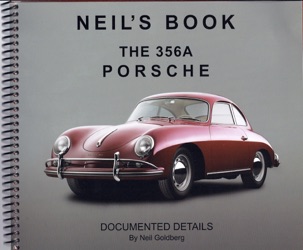Neil's Book The 356A Porsche Documented Details


AUTHOR Goldberg
ENGLISH
ISBN 10 no ISBN 10
ISBN 13 9780615395166
PRICE $60.00
LIST PRICE $60.00
AVAILABLE @ BLOCKS BOOKS
FROM EDITOR GORDON MALTBY’S REVIEW IN THE 356 REGISTRY
I'm going to write a book".
These are words I almost always digest with a large dose of skepticism. The only time I feel less confident of a successful outcome is when I hear, "I'm going to publish my own book".
Having seen many marginal outcomes when a well-meaning and enthusiastic person decides to share their knowledge with the world, I was ready with an open mind but not particularly high expectations when I first heard about "Neil’s Book". Even the title seemed a little too simple and maybe even narcissistic. Wasn't there something catchier?
"
Knowing Neil Goldberg, however, I was willing to give him the benefit of the doubt. If you have been to Stuart Tool in Troy, Michigan for his Saturday morning gatherings of Porsche nuts, or have seen some of the his outstanding restorations. You know he's well qualified to discuss the minutiae of these cars and their every component. Last time I visited, we talked at length about a 356's door light switch striker pad. How many people you know can state correctly how thick it should be? Neil can.
With high hopes and a little apprehension l looked through a copy at the East Coast Holiday where Neil was debuting his new title. My first impression was less than stellar: a ring binder is usually the kind of thing cookbooks come in. But getting over that hurdle is only a matter of turning to the first page (at which point you notice the cover is a nice, laminated heavy stock). Credits on the title page indicate an all star cast: Marco Marinello, editorial advisor, an introduction by Chuck Stoddard and
production by Sebastian Gaeta. A few pages on, the story begins with Chuck Stoddard recapping the story of Porsche and his own, unique history as a dealer for the cars. Interestingly,Chuck knew our subject car, 356A Coupe #103526 and its owner for five decades. He explains thai the car has had only a few parts replaced (parts he sold the owner, who did all maintenance himself), verifying its originality.
Chuck's description of his experience as a dealer and his relationship with Max Hoffman is some of the most compelling automotive history I've ever read. In just a few pages he gives you an overview of how Hoffman cannily developed a system that forced his dealers to buy other makes if they wanted more cars from Zuffenhausen, ensured through warranty claims that all parts were purchased through him, and generally had a simple approach to business dealings: "his way or no way".
Chuck goes on to put the production of this single Coupe into the perspective of Porsche's business growth at the time. Prices, profits, promotion and a detailed description of the production process from Reutter to Porsche are a fascinating backdrop as this particular car travels the assembly line. Detailed explanations of the record keeping (Reutter body books, Porsche fuel books and the Kardex) are accompanied by illustrations of each. One other key discussion is about dealers being able to re-title left-over models as a newer year car, since there were few apparent physical changes. The section ends with details about Porsche's efforts to terminate Max as US importer, a move that customers paid for for years afterward.
Whew! We've already had an intense history lesson and it's only page 15. Neil's photographs take over here, beginning with the exterior. He covers everything-and I mean everything -- visible. There is, however, no disassembly of parts, for which I applaud him; you don't scrape layers off the Mona Lisa.
In addition to the interior (which includes the warranty card, battery card, driver's manual cover, etc.), we have sections on the engine, front trunk and undercarriage. The tool kit pieces (yes, the wrenches have Hazet decals on them!) and even Koni shock markings are noted in detail. Shots from unusual angles give us details like the door bottom drain holes, the back of the dashboard and tail light reinforcing plates. I got a twinge in my back just imagining trying to get these shots.
Neils' images are uniformly sharp and well lit. Reproduction on the heavy, glossy paper is first-rate, and each page carries no more than two, so the details are easy to see. The captions are clear and helped by arrows the photos. By halfway through the book I was won over by the quality production values and even realized that pages laying flat in a spiral binding was a pretty good idea. Reaching the end at page 132 made me think, that's a lot of pages about one car. And one might ask, "Why?"
If you've ever done a restoration, especially on a ratty car with missing pieces, you'll have no question about this book's value. But even for the rest of us, there's the archeological fascination of seeing a time capsule opened, and I'm grateful to Neil for sharing it with us.
